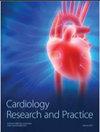冠状动脉钙化评分与冠状动脉狭窄之间的关系
IF 1.8
4区 医学
Q3 CARDIAC & CARDIOVASCULAR SYSTEMS
引用次数: 0
摘要
背景。冠状动脉钙化评分(CACS)通常用于量化冠状动脉粥样硬化的钙化程度。事实上,冠状动脉狭窄严重程度的增加与 CACS 的逐渐增加有关。研究目的本研究旨在探讨 CACS 与冠状动脉狭窄≥50% 和≥70% 之间的关系。方法。我们对江门市中心医院2017年7月1日至2022年3月3日期间收集的患者数据进行了回顾性分析。共纳入了208名有症状和无症状表现的疑似冠状动脉疾病(CAD)患者。统计分析包括ROC曲线评估、基于年龄的亚组分析以及CACS值与冠状动脉狭窄≥50%和≥70%的比较。结果。最终共纳入 208 名患者,中位年龄为 65.0 岁,中位 CACS 为 115.7(四分位间范围:13.7-369.4)。CACS阈值≥1300表明冠状动脉狭窄≥50%的特异性为100%。值得注意的是,与 65 岁以上的患者(3.8%)相比,65 岁以下患者(15.1%)中显示 CACS = 0 的阻塞性 CAD 患者比例明显更高()。当 CACS 在 63.3 到 66.0 的范围内时,冠状动脉狭窄≥50% 的风险概率从保护因素转变为风险因素的拐点就出现了。结论CACS 在检测冠状动脉狭窄方面表现良好。本文章由计算机程序翻译,如有差异,请以英文原文为准。
Relationship between Coronary Artery Calcium Score and Coronary Stenosis
Background. The coronary artery calcium score (CACS) is commonly employed to quantify the degree of calcification in coronary atherosclerosis. Indeed, increased coronary stenosis severity is associated with a progressive increase in CACS. Objectives. This study sought to explore the association between CACS and coronary stenosis of ≥50% and ≥70%. Methods. We conducted a retrospective analysis of patient data collected between July 1, 2017, and March 3, 2022, at Jiangmen Central Hospital. A total of 208 patients, presenting with both symptomatic and asymptomatic manifestations and suspected coronary artery disease (CAD), were included. Statistical analyses included ROC curve assessments, subgroup analyses based on age, and comparisons of CACS values against the presence of coronary stenosis ≥50% and ≥70%. Results. Ultimately, 208 patients were included, with a median age of 65.0 years and a median CACS of 115.7 (interquartile range: 13.7–369.4). A CACS threshold of ≥1300 demonstrated a specificity of 100% for coronary stenosis of ≥50%. Notably, the percentage of patients with obstructive CAD showing CACS = 0 was significantly higher in those under 65 years (15.1%) compared to patients over 65 years (3.8%) (). The inflection point, at which the risk probability for coronary stenosis of ≥50% shifted from being a protective factor to a risk factor, was observed when CACS fell within the range of 63.3 to 66.0. Conclusion. CACS demonstrates good performance for the detection of coronary artery stenosis.
求助全文
通过发布文献求助,成功后即可免费获取论文全文。
去求助
来源期刊

Cardiology Research and Practice
Medicine-Cardiology and Cardiovascular Medicine
CiteScore
4.40
自引率
0.00%
发文量
64
审稿时长
13 weeks
期刊介绍:
Cardiology Research and Practice is a peer-reviewed, Open Access journal that publishes original research articles, review articles, and clinical studies that focus on the diagnosis and treatment of cardiovascular disease. The journal welcomes submissions related to systemic hypertension, arrhythmia, congestive heart failure, valvular heart disease, vascular disease, congenital heart disease, and cardiomyopathy.
 求助内容:
求助内容: 应助结果提醒方式:
应助结果提醒方式:


